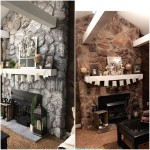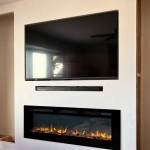Enhancing Fireplace Aesthetics and Safety with Fake Birch Logs
The allure of a crackling fireplace has captivated humanity for centuries. It evokes feelings of warmth, comfort, and nostalgia. However, the traditional wood-burning fireplace presents challenges, from the sourcing and storage of firewood to the maintenance required for safe operation. Fake birch logs, also known as artificial or faux logs, provide a pragmatic alternative that replicates the visual appeal of a wood-burning fire without the inherent drawbacks.
Fake birch logs are typically manufactured from ceramic materials, refractory cement, or specialized high-temperature plastics. These materials are chosen for their ability to withstand the intense heat generated by gas fireplaces, electric fireplaces, or gel fuel fireplaces. They are meticulously designed to mimic the natural appearance of birch logs, including the characteristic white bark, dark markings, and realistic textures. The manufacturing process often involves intricate molding and hand-painting techniques to achieve a convincing aesthetic.
The increasing popularity of fake birch logs stems from their numerous advantages. They eliminate the need for procuring, stacking, and storing firewood, freeing up space and reducing the physical labor associated with wood-burning fireplaces. They also offer a cleaner and more convenient alternative, as they do not produce ash, soot, or creosote. This minimizes the risk of chimney fires and reduces the need for frequent cleaning and maintenance.
Key Point 1: Advantages of Using Fake Birch Logs in Fireplaces
One of the primary advantages of fake birch logs is their ease of use. Unlike traditional wood-burning fireplaces, which require careful stacking and tending of the fire, fake birch logs are simply placed within the fireplace unit. They are compatible with various fireplace types, including gas fireplaces, electric fireplaces, and ventless fireplaces. The user can initiate the fire with the flick of a switch or the push of a button, enjoying instant heat and ambiance without the hassle of managing a wood fire.
Fake birch logs are also a safer alternative to wood-burning fireplaces. They eliminate the risk of sparks, embers, and flying ash, reducing the potential for accidental fires and burns. This makes them particularly suitable for households with children or pets. Furthermore, because they do not produce creosote, they reduce the risk of chimney fires, which can be a significant hazard with traditional wood-burning fireplaces.
Another benefit is their environmental friendliness. By using fake birch logs, individuals can reduce their reliance on wood as a fuel source, which helps to conserve forests and reduce deforestation. Wood-burning fireplaces can contribute to air pollution, releasing particulate matter and other harmful substances into the atmosphere. Fake birch logs, especially when used with gas or electric fireplaces, offer a cleaner-burning alternative with a lower environmental impact.
Finally, fake birch logs provide a cost-effective solution in the long run. While the initial investment may be higher than purchasing firewood, they can last for many years with proper care. They eliminate the recurring costs associated with buying firewood, as well as the expenses associated with chimney cleaning and maintenance. Over time, the savings can be substantial, making fake birch logs a financially prudent choice.
Key Point 2: Material Composition and Manufacturing Processes
The materials used in the manufacturing of fake birch logs play a crucial role in their durability, heat resistance, and aesthetic appeal. Ceramic logs are a popular choice due to their ability to withstand extremely high temperatures. They are typically made from refractory clay materials that are molded and fired in a kiln. The firing process hardens the ceramic, making it resistant to cracking and warping under intense heat.
Refractory cement is another common material used in the production of fake birch logs. This type of cement is specifically formulated to withstand high temperatures without degrading or crumbling. It is often combined with other materials, such as fiberglass or steel fibers, to enhance its strength and durability. Refractory cement logs are typically heavier than ceramic logs, but they offer excellent heat retention and a realistic appearance.
High-temperature plastics are sometimes used in the manufacturing of fake birch logs, particularly for electric fireplaces. These plastics are engineered to withstand the heat generated by the electric heating element without melting or releasing harmful fumes. They are typically lighter and more affordable than ceramic or refractory cement logs, but they may not be as durable or heat-resistant.
The manufacturing process typically involves creating a mold based on a real birch log. The mold is then filled with the chosen material, such as ceramic slurry or refractory cement. Once the material has hardened, it is removed from the mold and undergoes a finishing process. This may include hand-painting to add realistic details, such as bark patterns, knots, and cracks. The logs are then sealed with a heat-resistant coating to protect them from damage and enhance their longevity.
The artistry involved in creating realistic fake birch logs is often underestimated. Skilled artisans pay close attention to the intricate details of natural birch logs, replicating their unique characteristics with precision. They use a variety of techniques, such as layering colors, applying textures, and creating subtle variations in shade, to achieve a convincing and aesthetically pleasing result.
Key Point 3: Considerations When Selecting and Maintaining Fake Birch Logs
When selecting fake birch logs for a fireplace, it is important to consider the type of fireplace being used. Gas fireplaces typically require logs that are made from ceramic or refractory cement, as these materials can withstand the high temperatures generated by the gas flame. Electric fireplaces can often use logs made from high-temperature plastics, as the heat generated is less intense. It is crucial to consult the fireplace manufacturer's instructions to ensure that the chosen logs are compatible with the appliance.
The size and arrangement of the logs should also be considered. The logs should be sized appropriately for the fireplace opening, allowing for adequate airflow around the flames or heating element. Overcrowding the fireplace with too many logs can restrict airflow and reduce its efficiency. The logs should be arranged in a way that is both aesthetically pleasing and functional, creating a realistic and natural-looking fire.
Proper maintenance is essential for extending the lifespan of fake birch logs. While they do not require the same level of maintenance as traditional wood-burning fireplaces, they should be cleaned periodically to remove dust and soot. A soft brush or cloth can be used to gently wipe down the logs, removing any accumulated debris. Avoid using harsh chemicals or abrasive cleaners, as these can damage the finish and degrade the materials.
It is also important to inspect the logs regularly for any signs of damage, such as cracks or chips. If any damage is detected, the logs should be repaired or replaced promptly. Damaged logs can be a safety hazard, as they may not be able to withstand the heat generated by the fireplace. Replacing damaged logs will also help to maintain the aesthetic appeal of the fireplace.
Finally, store the fake birch logs properly when they are not in use. If the fireplace is not being used for an extended period, the logs should be removed and stored in a dry, protected location. This will help to prevent them from accumulating dust and moisture, which can lead to damage over time. Proper storage will also help to prolong their lifespan and maintain their aesthetic appeal.
In conclusion, fake birch logs offer a compelling alternative to traditional wood-burning fireplaces. They provide a convenient, safe, and environmentally friendly way to enjoy the ambiance of a fire without the associated drawbacks. By understanding the materials, manufacturing processes, and maintenance requirements of fake birch logs, individuals can make informed decisions and enjoy the benefits of a beautiful and functional fireplace for many years to come.

Diy Birch Wood Fireplace Cover For A Faux Insert

Diy Faux Birch Logs Winter Mantel Hi Sugarplum

How To Make Diy Faux Birch Logs Toolbox Divas

Birch Log Bundles Just For Show Faux Fireplace Home Decor

How To Make Diy Faux Birch Logs Toolbox Divas

Bundle Of Birch Logs Small Terrain

Artificial Birch Logs Fireplace Faux For Silk Plants Direct

Peterson Real Fyre White Birch Vented Gas Log Set Woodland Direct

Birch Log Bundles Just For Show Door Sixteen

White Birch Log Set For Fireplace Com
Related Posts








